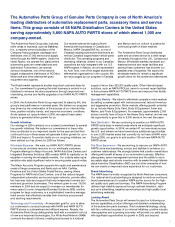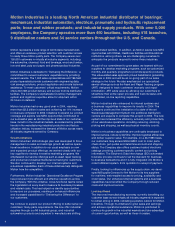Napa Auto Parts 2004 Annual Report Download - page 19
Download and view the complete annual report
Please find page 19 of the 2004 Napa Auto Parts annual report below. You can navigate through the pages in the report by either clicking on the pages listed below, or by using the keyword search tool below to find specific information within the annual report.
17
insurance and other expenses associated with the addition of
new Company owned stores.
Industrial Group
Industrial operating margins increased to 6.9% in 2004 from
6.7% in 2003. As a result of the improved conditions across
Industrial's customer base, combined with the benefits of internal
operating and other cost initiatives, Industrial’s operating profit
increased significantly. However, factors such as the decrease in
vendor discounts and volume incentives affected the growth of
Industrial’s operating margin in 2004. Industrial operating margins
decreased to 6.7% in 2003 from 7.9% in 2002, as overall lower
levels of vendor discounts and volume incentives earned in 2003
affected this segment the greatest.
Office Group
Operating margins in Office were 9.8% in both 2004 and 2003.
Initiatives to positively influence the customer and product mix of
sales, as well as to enhance the selection of selling tools available
to customers, helped Office maintain its operating margin. Office
margins decreased slightly to 9.8% in 2003 from 10.1% in 2002,
primarily attributable to customer and product mix.
Electrical Group
Operating margins in Electrical increased to 4.4% in 2004 from
2.4% in 2003. Electrical growth reflects the increase in sales to the
manufacturing sector, as well as continued focus on enhancing
sales margins and controlling costs. Electrical increased its margins
significantly to 2.4% in 2003 from .9% in 2002. Improvement in
2003 was due to efforts to reduce costs through headcount
reductions, branch closings and operating expense controls.
Income Taxes
The effective income tax rate decreased to 37.8% in 2004 from
38.1% in 2003. The decrease in 2004 is primarily due to favorable
permanent differences and the continued utilization of foreign
tax credits, as a result of certain favorable provisions in the
2004 Tax Act. The effective income tax rate decreased to 38.1%
in 2003 from 39.3% in 2002, primarily due to the utilization of
foreign tax credits in 2003 and lower state income taxes.
Net Income
Net income was $396 million in 2004, up 12% from $354 million
in 2003 before the cumulative effect of an accounting change
adopted on January 1, 2003. On a per share diluted basis, net
income was $2.25 in 2004 compared to $2.03 in 2003 before the
cumulative effect adjustment. After the 2003 cumulative effect
adjustment, net income in 2004 was up 18% from $334 million,
or $1.91 diluted earnings per share in 2003. Net income in 2004
was 4.3% of net sales compared to 4.2% in 2003 before the 2003
cumulative effect adjustment, and 4.0% of net sales in 2003 after
the cumulative effect adjustment.
Net income before the cumulative effect of accounting changes
in 2003 and 2002 was $354 million in 2003 compared to $368
million in 2002, a decrease of 4%. On a per share diluted basis,
net income before the cumulative effect adjustments equaled
$2.03 in 2003 compared to $2.10 in 2002. After the cumulative
effect adjustments, net income was $334 million, or $1.91 diluted
earnings per share, in 2003 compared to a net loss in 2002 of
$28 million, or $.16 diluted loss per share. In the first quarter of
2002, the Company completed impairment testing for goodwill in
conjunction with the provisions introduced in SFAS 142, resulting
in a non-cash charge of $395.1 million. This was recorded as of
January 1, 2002 as a cumulative effect of a change in accounting
principle. Net income before the cumulative effect of accounting
changes in 2003 and 2002 was 4.2% of net sales in 2003 compared
to 4.5% in 2002, and after the cumulative effect was 4.0% of net
sales in 2003 compared to -0.3% in 2002.
Facility Consolidation, Impairment and Other Charges
In the fourth quarter of 2001, the Company’s management
approved a plan to close and consolidate certain Company-
operated facilities, terminate certain employees, and exit certain
other activities. The Company also determined that certain assets
were impaired. During 2001, the Company recorded a charge
of $107.8 million ($64.4 million, net of tax), of which $89.5 million
were non-cash charges related to the plan. At December 31, 2004
and 2003, the Company had an accrual of $2.3 million and $3.3
million, respectively, recorded in accrued expenses relating to
lease obligations still outstanding on closed facilities.
Financial Condition
The major balance sheet categories at December 31, 2004,
with the exception of cash and accounts payable, were relatively
consistent with the December 31, 2003 balance sheet categories.
The Company’s cash balances increased $120 million from
December 31, 2003, due primarily to improved operating results,
stock option exercises and improved payment terms with certain
vendors. Our accounts receivable balance at December 31, 2004
increased 4% compared to last year, primarily due to our December
sales increase. Inventory increased 3% from December 31, 2003,
which is less than our 8% increase in revenues. The change in
inventory reflects our continued emphasis on inventory manage-
ment. Other assets at December 31, 2004 increased $60 million
due primarily to contributions into the Company sponsored
pension plans. Accounts payable at December 31, 2004 increased
$150 million from 2003 due to the Company’s increased purchases
associated with increased sales volume, as well as improved
payment terms with certain vendors. The change in debt is
discussed below.
LIQUIDITY AND CAPITAL RESOURCES
The Company reduced its total debt outstanding at December 31,
2004 by approximately $177 million compared to December 31,
2003. The decline in borrowings is primarily attributable to cash
generated from operating activities of $555 million and approxi-
mately $38 million generated through employee stock option
exercises. In addition, our dividends, stock repurchases, capital
expenditures and other investing activities in 2004 were compa-
rable to 2003.
The ratio of current assets to current liabilities was 3.2 to 1 at
December 31, 2004, and the Company’s cash position improved
significantly from December 31, 2003. The Company believes
existing credit facilities and cash generated from operations will
be sufficient to fund future operations and to meet its short-term
and long-term cash requirements.
Notes and Other Borrowings
In November 2004, the Company repaid in full a $125 million
debt financing with a consortium of financial institutions and
insurance companies (the “Notes”). The proceeds of the Notes
























